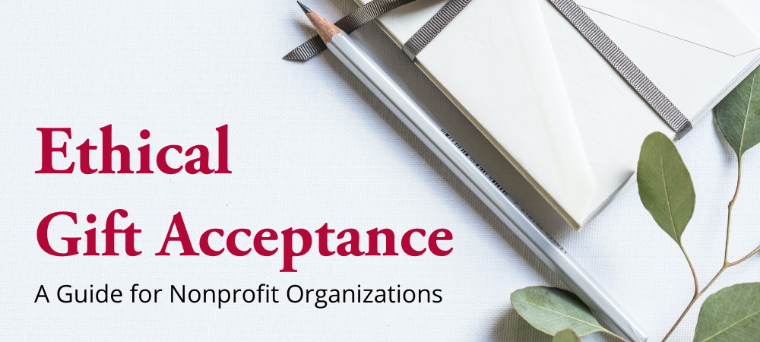
Joan Harrington is the director of Social Sector Ethics. Anita Varma is the assistant director of Social Sector Ethics as well as Journalism & Media Ethics. Views are their own.
Jeffrey Epstein and the Sackler family are the most recent names in the news about controversial donors and what nonprofits should do about them. Donors become controversial based on how they make their money or due to their personal behavior.
Some argue that the source of a contribution is irrelevant and nonprofits should take money from any and all donors--controversial or not--as Mother Teresa did. But the majority of nonprofits and the public do not adhere to this philosophy, and nonprofits struggle to make ethical decisions about problematic gifts.
Making ethical decisions requires sensitivity and a practiced method for exploring the ethical aspects of a decision to weigh the relevant considerations. Ultimately, the final decision rests with the nonprofit organization, but nonprofits would benefit by starting their process of ethical decision making by using a framework for potentially problematic gifts.
The Markkula Center for Applied Ethics’ framework for ethical decision making provides crucial guidance for nonprofits to develop a framework for their own organization. This framework is tailored for decision makers such as members of the board of directors, fundraising officers, and others working in development in an organization.
1. Identify the ethical issue.
Accepting or keeping a gift from a donor that made money or behaved in objectionable ways raises an ethical issue for nonprofits. For example, making money from a business that exploits children as factory workers may leave a person with plenty of funds to donate--but it also raises an ethical issue: is it right to take funds that came about from exploiting a vulnerable group’s labor to turn a profit? Advocates for working conditions and child labor protections would say no and fundraisers, nonprofit managers, and board members should be sensitive to the fact that these types of gifts raise ethical issues.
It can be difficult to recognize ethical issues in gift acceptance in part because nonprofit fundraisers often discuss charitable donations in terms of size and contribution to an annual revenue goal, and may not intuitively scrutinize the source of the donation. All gifts should be assessed in terms of whether they are objectionable or defensible from an ethical perspective--not just in terms of whether they are sizable or small from a financial perspective.
2. Get all of the facts.
a. Consider the interests of individuals and groups with a stake in the outcome.
The categories of stakeholders that nonprofits need to consider in decision making are generally consistent across the sector. These stakeholders are the nonprofit itself, including employees and volunteers; donors, past and present; those who use the nonprofit’s services; and the public. The specific nature of these stakeholders and the significance of their interests is different for each nonprofit.
The Metropolitan Museum of Art’s decision to stop taking donations from the Sackler family, who is linked to the opioid crisis through their company Purdue Pharma, illustrates the challenge of fully appreciating all of the nonprofit’s stakeholders.
In March of 2019, several major museums decided to stop taking donations related to the Sackler family. Britain’s National Portrait Gallery returned a $1.3 million gift and the Tate Museum and the Guggenheim Museum refused any additional gifts from the family. The Metropolitan Museum of Art did not take action in March and was met with protests, including one in which participants threw pill bottles into a major exhibit and engaged in a “die-in,” generating negative press coverage. In May, the Met announced its decision that it would no longer take donations from the Sackler family.
In the press release, the Met also announced that they had amended their gift acceptance policy by consolidating decision making on gift acceptance and allowing for consideration of the impact of the gift on the public interest. In explaining its decision with respect to the Sackler family, the president stated: “…on occasion, we feel it’s necessary to step away from gifts that are not in the public interest, or in our institution’s interest.”
Consideration of what is in the public interest is relevant not only to the public as a whole, but to donors, museum goers, artists, employees, and volunteers. Consideration of the public interest implications of the Sackler gift allowed the Met to best pursue its mission in light of its stakeholders.
b. Ask whether some stakeholder’s concerns are more important than others and why. Consult with stakeholders.
The identity of the stakeholders and how they are valued by the nonprofit can impact the decision on whether to accept or keep a donation.
Martin Shrekli was a young executive who, shortly after buying a pharmaceutical company, increased the cost of cancer and AIDS drugs dramatically, raising the cost of one life-saving drug for pregnant women, cancer patients, and people with AIDS over 5,000 percent. As part of his philanthropy, he donated $15,000 to Community Solutions, an organization helping homeless people, and $1 million to his high school alma mater, the Hunter College High School (HCHS). In response to Shrekli’s price increases of certain drugs, Community Solutions returned the gift, but HCHS did not. The nature of the stakeholders and their concerns impacted these organizations’ decisions.
For Community Solutions, Shrekli’s behavior in raising drug prices directly impacted their clients, whom they valued most highly. The nonprofit’s leaders discussed the issue and decided to return the gift stating: “[w]e serve people who depend on access to AIDS meds every day, and as an organization I don’t think we can keep this money.” In this case, the donor’s business actions potentially harmed the clients’ interests and were in conflict with the nonprofit’s mission.
HCHS decided to keep the gift of $1 million. Some alumni and students, both groups with a stake in the outcome, urged the high school to return the gift. But HCHS did not, saying that they had undertaken a “thorough review” with the Hunter College Foundation alumni and others and concluded that the best decision was to keep the money. The funds would be used to improve the school and help with expenses for those who could not pay. In this case, the nonprofit identified and listened to its stakeholders, weighed their interests and concluded that accepting the funds did not contravene the nonprofit’s mission and values.
Universal approval of particular outcomes is an implausible standard. Ethical decision making in such cases involves the organizations doing due diligence to identify those parties most interested in the decision of whether to keep the problematic gift, and evaluating the stakeholder concerns in making the decisions to keep the gifts to reach a publicly defensible conclusion.
3. Identify possible options and evaluate them with the lens of the organization’s mission and values.
Nonprofits define their work through their mission statement and the principles that guide nonprofits should be reflected in their statements of values. A nonprofit working toward its mission is paramount as the mission is the basis for a nonprofit gaining tax exemption. The public effectively subsidizes nonprofits with the understanding that these tax-exempt organizations will maximize their contribution to the public good through fulfillment of their missions. In addition, nonprofits present and publicize mission and values to all of their stakeholders. There are other ethical approaches that may be used as ethical lenses, but an organization’s mission and values should be primary.
Most of the larger nonprofits follow the best practice of having a gift acceptance policy with a provision stating that the nonprofit may elect to refuse gifts that are not consistent with the nonprofit’s mission or values. Whether the policy is in place or not, when making a decision about a potentially problematic gift, nonprofits should use their mission and values as the ethical lens when evaluating their options when faced with a controversial gift.
Options
- Refuse the gift.
Refusing the gift means declining to accept the funds offered. If an organization compares their mission and values to the behavior and actions of the donor and finds that the donor has acted in direct opposition to the organization’s mission and values, which is being echoed by key stakeholders, then the organization has an ethical obligation to decline to accept the gift. Otherwise, the organization is no longer acting in adherence with its mission, which is its primary duty.
ii. Return the gift.
In some cases, accusations and convictions or other confirmation of wrongdoing take place after a gift has been accepted, and there was no way to know that these accusations and convictions would arise. For someone who has no past record of embezzlement, for instance, figuring out that this person is embezzling funds may not be within the capacity of any fundraising team, no matter how robust. Nonprofit organizations often must act in conditions of informational asymmetry, where the donor purposefully hides relevant context in hopes that the gift will be accepted. When such behavior comes to light, however, nonprofit organizations are not in a position to continue to plead ignorance as the basis for keeping the gift as planned.
If an organization’s mission, values, and stakeholders’ interests are all contradicted by the donor’s actions and wrongdoing, then the organization has an ethical obligation to return the gift, if there are funds remaining. If there are not funds remaining, the organization does not have an obligation to raise more funds simply to return the equivalent amount, but must act transparently, making clear how the funds were used and the timeline of funds being accepted before the accusations and confirmation of these accusations came to light.
iii. Retain the gift.
If an organization’s mission, values, and stakeholders do not identify an issue with accepting a donation, even if the donor has either earned the money through potentially objectionable means or has a problematic past, there may not be a need to take further action – other than drafting a public statement to explain this process publicly. For example, someone who has worked at an oil company while a major oil spill took place may seek to donate to an education technology nonprofit. If the mission and values of the education technology nonprofit are still upheld and stakeholders are aware but do not find the donor’s professional history concerning from the perspective of developing education technology for students, then it would be ethical for the organization to retain the gift. The same may not be true for an environmental nonprofit, which would have different stakeholders and a distinct mission to consider when assessing the gift.
iv. Retain the gift, but devote it to efforts to address the social problem the donor’s actions contributed to or created.
Ethics is about doing what is right for society, not just for a private organization or individual. There is a compelling argument to be made that what is best for society is not for controversial donors to hoard their funds, and that a better place for their funds is in the nonprofit sector, specifically to provide services and support for communities victimized by their actions. In some cases, this amounts to a nonprofit not returning the problematic gift to the donor and dedicating the funds to a different sector that offers services for people affected. If, for example, a donor participated in a scheme to make medications prohibitively expensive for impoverished patients which comes to light after an organization has accepted the donation, one ethical option would be to give the funds to another organization that aims to provide affordable access to healthcare and treatment for the specific community that the donor negatively impacted.
4. Which option best addresses the situation? Make a decision and test it.
In making a decision with respect to a problematic gift, a nonprofit should consider how outsiders might view the decision and think about how it will be portrayed by the media. If a nonprofit has followed the framework, they should have a well-reasoned, defensible position to explain their decision.
Nonprofits should also consider how the decision can be implemented with the greatest care and attention to the concerns of all stakeholders.
5. Act and reflect on the outcome.
Reflection helps inform the next decision and allows this process to become a practiced mechanism for ethical decision making, both for individual decision makers and for institutional history.
Controversial donors can make it challenging for nonprofit organizations to fulfill their missions. When public scrutiny focuses on a controversial donor and ignores the contributions of the organization to communities--while also making future donors wary of offering support and alienating stakeholders--organizations may find themselves wondering whether the controversial donation was worthwhile at all. At the same time, nonprofit organizations inevitably need donor funds, and it is rare for a donor to be completely free of potential controversy. The goal of the ethical framework above is to provide nonprofit organizations with a set of steps to utilize when assessing donors, and to offer a vocabulary for how they might begin to justify decisions to refuse, return, or retain a gift.




